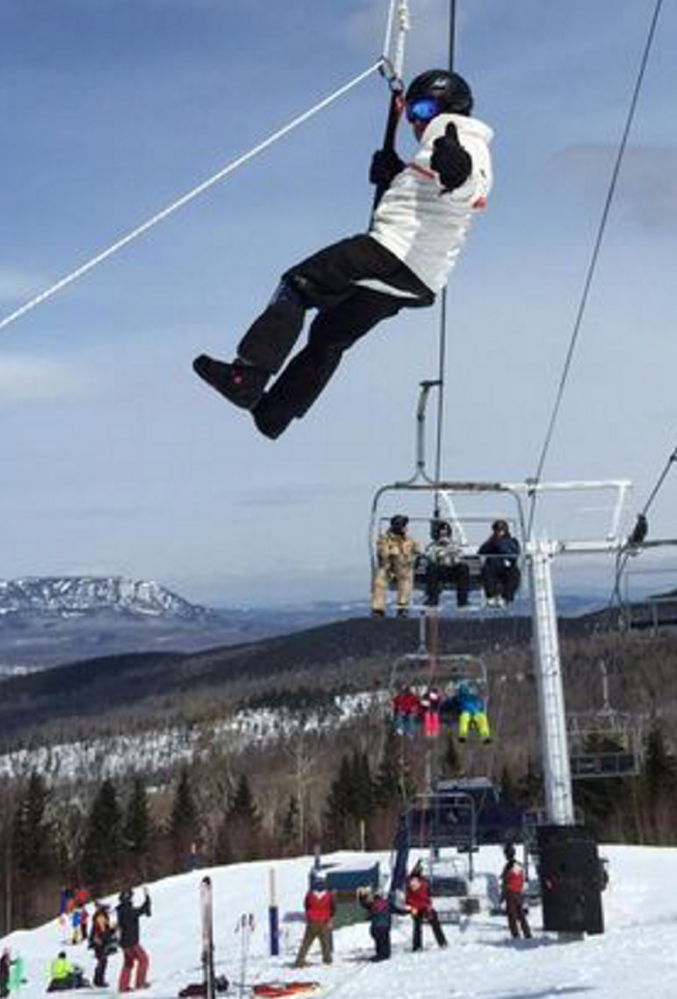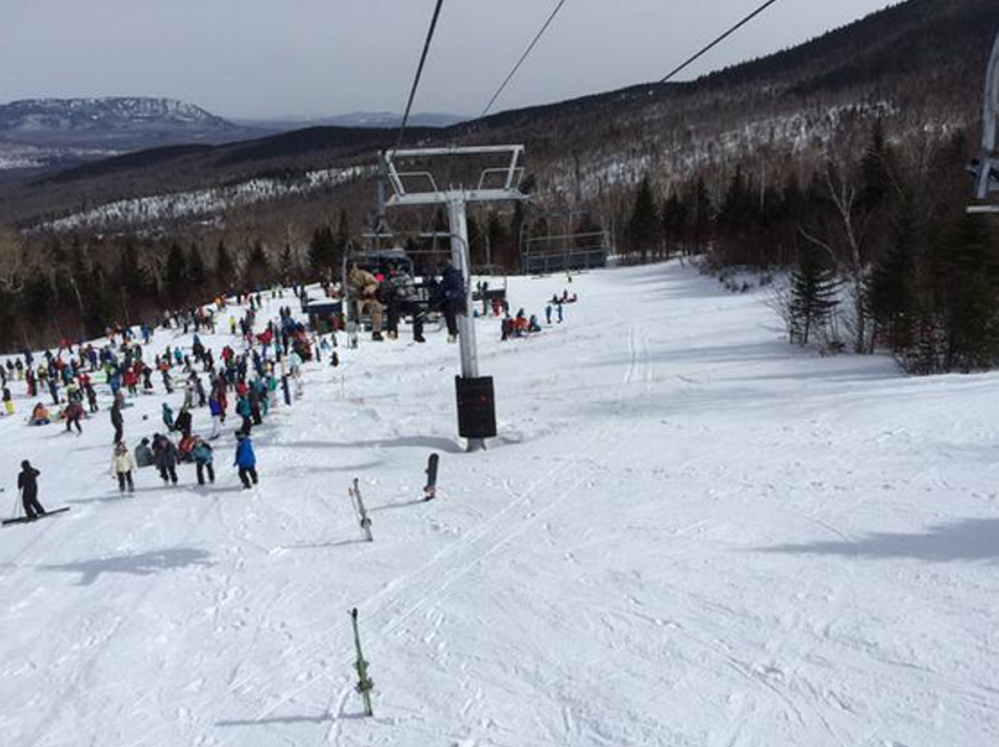Engineers investigating the chairlift malfunction that injured seven skiers at Sugarloaf Mountain Resort on Saturday have identified a design flaw in one of the emergency braking systems, a problem that has been found on six other lifts at the mountain and could affect lifts at ski resorts across the country.
The six lifts were shut down Wednesday when the flaw was discovered, and repairs were made. Most have been returned to service, Sugarloaf said in a statement.
The statement said Sugarloaf has completed its preliminary investigation of the incident. It determined that a rare “rollback” occurred on the King Pine chairlift Saturday when a drive shaft fractured. The shaft delivers power from the motor to the bullwheel, the large wheel that pulls the cable.
When the shaft broke, the fully loaded chairlift reversed direction, rolling backward 460 feet, the distance between nine chairs. Many skiers jumped from the moving lift, which caused at least some of the injuries. The people who remained on the lift were helped to the ground by the ski patrol at the Carrabassett Valley resort.
The broken drive shaft made the primary service brake and anti-reverse brake ineffective, said the statement by Sugarloaf Mountain Resort spokesman Ethan Austin. Ultimately, an emergency brake, which consists of calipers applying pressure that gradually slows the bullwheel, did work. It is designed to slow the lift gradually because suddenly stopping a moving lift can cause skiers to fall out of their chairs, or cause the cable to come off the wheels on the towers that suspend it.
In 2010, the cable came off the wheels on one of Sugarloaf’s chairlifts and five chairs fell to the ground, injuring eight people.
The day after Saturday’s accident, officials said the emergency bullwheel brake had to be applied manually because it failed to activate automatically. But on Wednesday, the resort said the automatic mechanism did work at about the same time the lift attendant pulled a lever to activate it.
A final redundancy in the braking system, called a drop dog, did not work, however. The system is designed to have a large metal pin drop into the spokes of the bullwheel to stop it from rotating.
Engineers determined that a switch designed to hold the drop dog above the bullwheel as it spins forward can also keep it from dropping into place if the bullwheel rotates in reverse, Austin said.
“In theory, it only does it when the lift is in forward motion. If it starts going in reverse, it wants the drop dog to drop into place and stop the rollback immediately. This switch works in both directions,” Austin said. He said he didn’t know whether Saturday’s malfunction was isolated or happens consistently, making the drop dog entirely ineffective.
The switch was provided by the lift’s manufacturer and continues to be provided by the company that makes parts for that type of lift.
PROBLEM HAS EXISTED SINCE 1988
Engineers tried two new replacement components and each had the same problem, leading them to conclude that it is a design flaw, Austin said. Had the switch functioned, the drop dog would have activated and stopped the rollback, Austin said.
A drop dog test is part of the daily lift inspection, Austin said, but it can’t be done in real world conditions.
“You can’t really allow the lift to build up as much momentum as it did in this case,” he said. “You allow it to roll back until the drop dog drops. In those tests, the switch wasn’t rotated enough to generate enough current where it would lift the drop dog.” It’s not clear why the mechanism didn’t activate immediately on Saturday, before the rollback picked up speed.
The flaw apparently has existed on the King Pine quad chair since it was installed in 1988, as well as on four other Sugarloaf lifts manufactured by Borvig that have the same type of braking mechanism: Skidway, Snubber, Double Runner East and Double Runner West.
Sugarloaf’s Sawduster and Bucksaw lifts, built by Stadeli, have the same type of braking system employing the same switch and were also affected, Austin said.
Engineers for Boyne Resorts, which operates Sugarloaf; ski resort employees and a licensed Maine lift inspector designed circuitry to correct the problem – a fix approved by state regulators – and installed it in all the lifts except Bucksaw, which was scheduled to be shut down for two days anyway, Austin said.
The lifts are mostly lower-mountain beginner lifts and did not have a major impact on the mountain’s operations. They were shut down from noon to 1 p.m.
Two lifts at Sunday River in Newry also had that type of switch and were retrofitted, Austin said. He said he was told by Boyne Resorts’ senior vice president of mountain operations that it appears none of the company’s other resorts have that apparatus.
FLAW LIKELY AT MORE THAN 150 LIFTS
But there are many other resorts that probably do. Sugarloaf and Boyne have been in contact with the company that makes parts for that type of lift, and Austin said that typically a service bulletin would be issued by the manufacturer to customers who have that type of equipment.
Dave Byrd, director of risk management for the National Ski Area Association, said he had learned about the design issue but did not know whether the Maine-approved retrofits would be done in other states, particularly so near the end of the season. The design issue seemed to primarily affect Borvig lifts installed in the 1980s.
Byrd said that there are about 150 such lifts nationwide.
Even though the design flaw appears relatively common, it would not necessarily have shown up previously, Austin said. Having a catastrophic failure of a drive shaft happens, but is unusual – particularly in such a way that the primary and anti-reverse brake don’t work.
“Rollbacks are incredibly rare events,” Austin said. “Drive shafts like this do break, but when it happens, braking systems work as designed and they stop and all you have is a lift evacuation.”
King Pine passed its annual inspection before the season started and also – along with the mountain’s other lifts – was subjected to a vibration analysis the day before Saturday’s malfunction. The vibration analysis is supposed to identify parts that have become fatigued before they break.
Sugarloaf General Manager John Diller issued a statement Wednesday that read: “Our first thoughts remain with those injured, and our sincere hope is for their speedy recovery. I’m grateful that we now have a clearer understanding of what occurred.”
The King Pine chairlift probably will not reopen this season, Austin said.
The lift was scheduled to become a weekend-only lift after the mountain’s popular Reggae Festival, which happens April 9-12.
“There were only 10 to 15 days scheduled to operate the lift anyway,” Austin said. Given that the gearbox has significant damage, and that it would take time to order replacement parts, there is little chance the lift will run again this season, he said.
Doug Dunbar, spokesman for Maine’s Board of Elevator and Tramway Safety, said the agency was not prepared to release information about the investigation Wednesday.
“Sugarloaf representatives are obviously free to share whatever information they wish to offer, but the department will complete a thorough review as quickly as possible and provide its findings at that time,” Dunbar said.
David Hench can be contacted at 791-6327 or at:
Twitter: @Mainehenchman
Send questions/comments to the editors.




Success. Please wait for the page to reload. If the page does not reload within 5 seconds, please refresh the page.
Enter your email and password to access comments.
Hi, to comment on stories you must . This profile is in addition to your subscription and website login.
Already have a commenting profile? .
Invalid username/password.
Please check your email to confirm and complete your registration.
Only subscribers are eligible to post comments. Please subscribe or login first for digital access. Here’s why.
Use the form below to reset your password. When you've submitted your account email, we will send an email with a reset code.